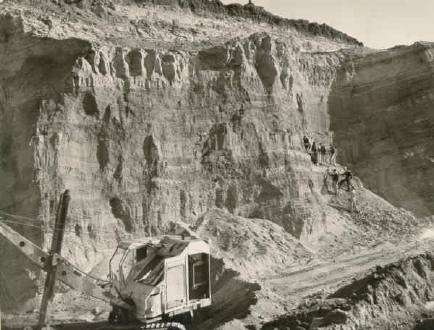|
Descriptive Data
Hundreds of thousands of cubic yards of clay, sand, and gravel have been
taken from the Irvington deposits by workmen using bulldozers and power shovels.
Most of the walls of the excavations are vertical, and many of them are more
than 100 feet high. These walls contain clues about how and when particular
strata were deposited. How a paleontologists, Donald E. Savage of the University
of California employed the clues at Irvington and noted and studied what he
found and how he interpreted his findings are worth our attention.
 |
| Amateur paleontologists are searching for
fossils in the exposed strata. |
First, he collected his data. Along a line running northeast to southwest
across Locality V3604, Savage investigated about 270 feet of exposed strata.
When he completed his study, he recorded the findings in tabular form. He
described the strata that contained fossils and indicated were the fossils were
found. He described the different types of sediments found at different
elevations. He also indicated distinct cross-bedding. The exposures contained
information that will, if correctly interpreted, provide a base on which you may
reconstruct scenes depicting biotic and abiotic events at Irvington.
This information is useful when we attempt to answer such questions as:
Were all the animals buried at the same time? Were some beds especially rich in
fossils? Did the ancient streams flow more rapidly at some times that at others?
Did the streams change direction from time to time? Did earth movements raise or
lower the area during the time the sediments were being buried? While looking
over the paleontologistís data table (Figure 8), notice how he arranged his
data.
Such an arrangement helps you to visualize the geologic conditions more
clearly. Suppose the data in the columns had been presented like this:
-
Greenish-gray mudstone, 8; gray friable sandstone, 15; cobble gravel,
4-6; tough gray sand, 7-9; sandy pebble-cobble gravel, 8-12; and so forth.
You probably would have been tempted either to rearrange the data or to
stop reading. But there is no reason why the data could not be presented clearly
in another way. Draw a vertical section of your own, using a sheet of paper
large enough to permit a scale of 1/8 inch to represent 1 foot. At this scale
the section should be about 34 inches long. Color the different strata according
to the descriptions given by Savage.
| Figure 8: Description of
sediments and Fossil Remains, Locality V3604, Irvington District,
Fremont, Alameda County, California. |
|
Lithology |
Thickness
(in feet) |
Fossil Remains |
| (Vertical Section of Quarry) |
|
|
| Fine to medium grained sandstones
and mudstones, deep tan with brown-red area; soft (uncemented),
showing some cross-bedding. |
70 |
|
|
| Sandy cobble gravel (cobbles vary
from 64 to 256 mm in diameter), poorly sorted (mixed with sand) |
48 |
|
Small fragments of bone |
| Soft, gray sandstone, distinctly
cross-bedded |
23 |
|
Mammuthus, mammoth, Equus, horse;
Camelops, Irvington Camel |
| Pebbly and gritty sand (pebbles
vary from 4 to 64 mm in diameter), with channeling. The
cross-section of a complete stream channel-fill is exposed |
20 |
+/- |
Mammuthus; Equus; Camelops;
Tetromeryx, antelope; Canis, dire wolf |
| Soft, gray sandstone |
10 |
+/- |
|
| Loose, medium-grained, gray-green
sand (1/4 - 1/2 mm) |
1 |
+/- |
rodents |
| Soft, gray sandstone with
carbonized (changed to coal, charcoal, or carbon) and limonitized
(altered by iron oxides or iron hydroxides) wood fragments |
7 |
+/- |
|
| Loose, coarse, gray-green sand
(1/2 to 1 mm) |
2 |
+/- |
Camelops; Equus; Terameryx;
rodents; turtle |
| Brown-yellow to gray claylike
sand with scattered pebbles and pebbles with lens-shaped cross
sections; grades downward into tougher (compacted) sandstone |
20 |
+/- |
All Irvington mammals except some
rodents; includes fish, amphibians, turtles, birds, snails, clams,
twig imprints, and leaf imprints |
| Pebble-cobble gravel with
lens-shaped cross sections |
10 |
|
Mammuthus; Camelops; Arctodus, a
gigantic bear |
| Green-gray mudstone |
8 |
|
|
| Gray friable sandstone |
15 |
|
|
| Cobble gravel |
5 |
|
|
| Tough, gray sand |
8 |
|
|
| Sandy pebble-cobble gravel |
10 |
|
Mammuthus; Equus; Camelops |
| Tough, gray sand (bottom of
exposed section) |
11 |
|
Mammuthus |
| Total Thickness |
270 |
+/- |
|
|